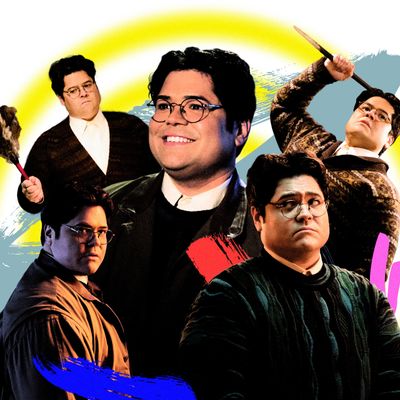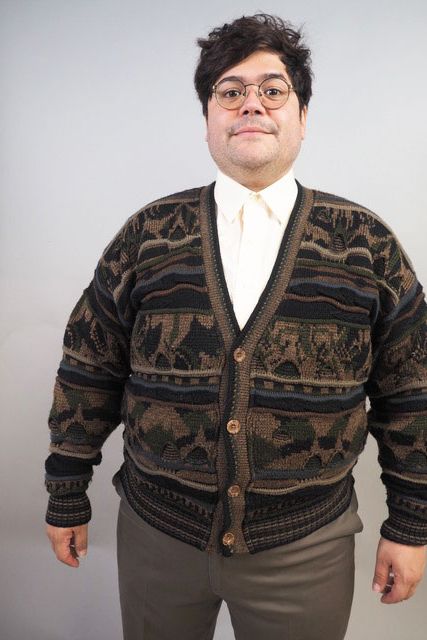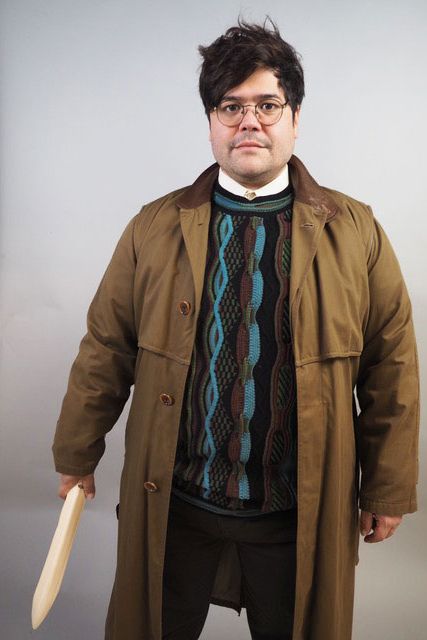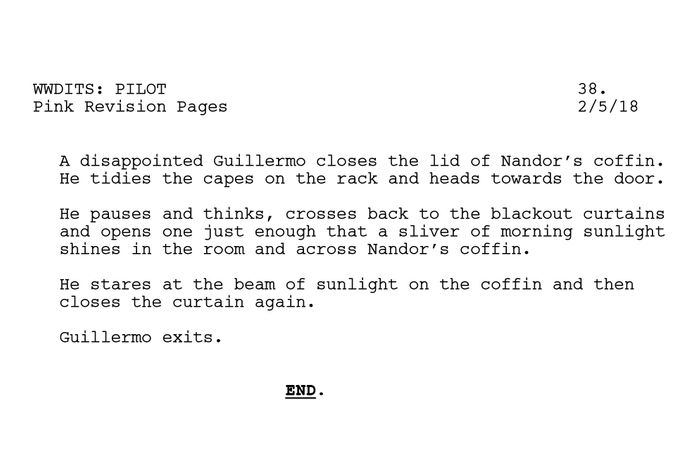
The character: Guillermo De La Cruz, familiar to a vampire named Nandor for a decade. Only human member of a houseful of vampires on What We Do in the Shadows. Former Panera Bread employee.
The actor: Harvey Guillén, 30, has described the 1982 movie Annie as his inspiration for becoming an actor. His first major TV role was on the critically acclaimed but short-lived ABC series Huge in 2010, followed by supporting roles on Eye Candy and The Magicians before being cast on the pilot of What We Do in the Shadows.
Essential traits: Loyal, diligent, and thorough; polite and unassuming to a fault; not comfortable drawing attention to himself. Descendant of Van Helsing. Preternaturally good at killing vampires but nevertheless desperately wants to become a vampire.
The Familiar
What We Do in the Shadows was developed from a 2014 movie of the same name, written, directed, and starring Taika Waititi and Jemaine Clement. When Waititi and Clement began adapting the concept for TV in 2017, they knew a familiar — basically, a vampire’s devoted assistant — would need to be central to the premise. Much of the film was improvised, which meant Clement and Waititi shot a lot of material that didn’t make it into the final cut, including scenes with a familiar character named Jackie. “We filmed a lot of great stuff with her, but we didn’t get to fit it all in, because we were trying to make a short movie,” Clement says. “But it seemed like an interesting part of it that you hadn’t seen before.”
On paper, Guillermo’s role would also be an important way for the show to mark how bizarre and goofy its vampire world would be, especially given its mockumentary format. It was a small but critical shift from the movie, which featured familiars doing basic chores but still living in their own homes. On the show, Clement felt it was important for Guillermo to be around at all times. “If [the familiar] has been in the house for a long time with the vampires, he might’ve forgotten how strange it is,” Clement says. “If the cameras are there, it’d be a reminder for him that he’s a connection between the audience and the vampires.”
Clement had a specific actor in mind to play the familiar, and because that actor was Latinx, the character was written into the script as a man named Guillermo rather than a woman named Jackie. But when that actor didn’t work out, Clement and the Shadows team began auditioning all kinds of actors for the role. While Clement and Waititi looked for the right person to play Nandor, the vampire to Guillermo’s familiar, casting agents back in L.A. spearheaded the search for Guillermo himself. (“Most of the people they auditioned were white guys. It annoyed me so much,” Clement says.) But in addition to wanting the cast a Latinx actor, it was really hard to find someone who understood Guillermo. “Taika and I would give people clues of what we were looking for,” Clement recalls. Guillermo needed to be a human, first and foremost, with human feelings. When they’d start improvising during the auditions, though — a vital test because the show would often use improv — actors would “sort of forget” who Guillermo was. “They’d always go this dark way, basically suggesting he was a murderer … which is true … but …” Clement says. “Harvey got it straight away. He knew that he was the warmest part of the group.”
“I don’t want anyone to imagine that we had the character super well-formed in our heads, and Harvey was the one who checked the boxes,” showrunner Paul Simms says. “We had some idea that he works for Nandor and he wants to be a vampire. It was more Harvey coming in with an original take that I don’t think we could’ve even described in words.”
The Audition
For Guillén, who stumbled into an audition opportunity after learning about the role at a party barely 24 hours earlier, reading the script and thinking about the character held several important hints about who Guillermo should be. The first was simple: It may seem superficial, but for Guillén, the name Guillermo was key. “I was thinking, Do I know any Guillermos? And I thought, Oh, Guillermo del Toro. How cool he is, the side of him that’s so artistic and loves that world of darkness and goth. I thought, What a great name for someone who lives in that world.”
Crucially, though, Guillén knew that Guillermo did not entirely belong in a del Toro-esque dark vampire world. “I went in thinking that he himself is not that yet, but his goal and aspiration is to become that. He is probably very much the opposite of that,” he says. “He must be at the complete opposite of that spectrum right now.”
To communicate all of that, Guillén thought carefully about how Guillermo’s clothing could signal his place in the vampire world. “He should be put together, but not fashionable,” Guillén thought as he prepared for the audition. “You never want to wear something risqué. You don’t want to rock the boat, you don’t want to make waves. He’s very safe. Safety gets you under the radar.”
The image Guillén created for his audition essentially became the character who ended up onscreen. He found a large pair of round glasses, pulled out a nondescript sweater he hadn’t worn in years, and parted his hair in the middle, both to create a “Bram Stoker essence” and because it looked both innocent and unfashionable.
“He was very sweet, and also he didn’t seem like a dimwit,” Simms says about Guillén’s audition. “It wasn’t that he was a dummy; it was more that he had a lot of passion for being a vampire and was willing to make sacrifices for it.”
Neither Clement nor Waititi were at Guillén’s audition; they were still in London casting the role of Nandor, which ultimately went to Kayvan Novak. But they and the rest of the production team unanimously approved Guillén’s audition tape, and a few hours later he got a call from his agent because he’d been asked back to do another test. A few days after that, before the test had even been scheduled, Clement and Waititi called Guillén directly, for what he assumed was just a discussion about the role. In fact, his audition had been so unquestionably perfect that they wanted him to come straight to set the next week. All those hints Clement and Waititi had to keep giving other actors about who Guillermo should be? “Him, we didn’t need to give any clues.”
Guillén’s concept of the character was so fully formed that when he arrived on-set, he expected to have a whole conversation with the costume and hair designer about Guillermo’s look. The vampires, after all, had elaborate concept boards for their characters, featuring inspiration from iconic film vampires and ornate, old-fashioned clothing. For Guillermo? “Wardrobe had a picture as a reference which was just a still of my audition tape,” Guillén says. “That went to wardrobe, and they said, ‘This. Re-create this.’”
The Vampire Slayer
At the end of season one, Guillermo sends away samples of the whole household’s DNA so they can trace their ancestry. (For centuries-old vampires, this includes both where they came from and all of their many descendants.) To his shock, he discovers that he’s a descendant of Abraham Van Helsing, the famous vampire hunter, who first appeared in Stoker’s Dracula novel. Guillermo’s heritage is the twist that ends Shadows’s first season, and it’s the basis for the main arc of season two. It’s a surprisingly moving story, an unspooling thread that forces him to question his position as a familiar and slowly demand more respect from Nandor.
The ideas started with a note from industry powerhouse Scott Rudin, one of the show’s executive producers. “His main note on my pilot script was that Guillermo should have some power. You know, ‘find some power,’” Clement says. “I hated that idea, and I told him that.”
Clement thought that Rudin’s idea would fundamentally alter Guillermo’s dynamic in the household: Rather than the subservient, well-meaning, long-suffering servant, he’d become manipulative and purposely antagonistic. It was counter to his entire idea of who Guillermo should be. “I wanted him to be the moral compass,” he says. But with Rudin’s note in mind, Clement added a moment at the end of the pilot where Guillermo toys with the idea of killing Nandor. After Nandor celebrates Guillermo’s tenth anniversary of becoming a familiar by giving him a glitter portrait — rather than fulfilling his fondest desire of becoming a vampire — Guillermo closes Nandor into his coffin for the day and then stands at the window, playing with a curtain. For just a brief moment, we can see Guillermo holding the curtain ajar, letting in the daylight that would kill his master.
“When I saw that moment, that was a big lightning bolt for me, of going, whoa, maybe he’s a vampire killer,” Clement says. “Maybe he’s destined to kill vampires, that’s what he’s good at, and it’s the opposite of what he wants.”
Although Clement could see the possibility in the show’s pilot, he saved the idea of Guillermo as an heir to the Van Helsing bloodline until the season finale so that it could become the driving conceit for the show’s second season. For almost the entire run of season two, Guillermo’s newly discovered talent as a vampire killer is kept secret from Nandor and the rest of the house. It’s a hilarious secret: Guillermo spends much of the season casually killing vampires without even thinking, so easily that it’s obviously a second nature to him. That Nandor and the rest of the vampires don’t realize it speaks to how clueless they are, and how little they appreciate all the things Guillermo does for them.
But it’s a secret Guillermo wrestles with, so much so that he tries to actually tell his master more than once. He offers it up right away, in fact, as soon as he gets the DNA test results in season one’s finale, but is rebuffed. He tries again midway through season two, after the household energy vampire, Colin Robinson, has drained everyone and Guillermo assumes they’re all dying, but once again Nandor ignores him. To Guillén, those are quintessential Guillermo moments, “He is literally trying to come clean and confess,” Guillén says. “Maybe this is a part of him that was raised Catholic.”
It’s one of the central tensions of who the character is: “Guillermo is very modest,” Guillén says. “There’s something about him, that even though he lives with these vampires who talk about semen and sex and orgies, he’s very much not like that. You don’t know much about Guillermo and his personal life.” It’s not hard to understand why: “No one ever asked him.”
What that means, though, is that Guillermo’s Van Helsing heritage is a secret, and so are any more deeply held feelings he might have toward Nandor. The idea that Guillermo might actually be in love with Nandor was something Guillén developed when they filmed the pilot, and he threaded it through his performance as the show continued. “A couple of times in his improv, he suggested having a crush on his master,” Clement recalls. It’s never become an explicit part of the show, but it’s something Guillén sees as a lurking suggestion of how to read their relationship. “He’s very loyal to his master. There’s a thin line of, Wait, are you in love with your boss?” Guillén says. “There has to be a balance because it can be too much,” he says, but it’s an idea he enjoys shading into their relationship. “You start living with someone for ten years and doing things for each other where it is like a couple, looking after each other. You start thinking, Is this a relationship? Is this a platonic relationship, or …?”
For now, any development along those lines will remain an undercurrent. “A big part of the sacrifice to do this job is giving up any relationship,” says Clement. Together with the Van Helsing secret, though, the question of Guillermo’s feelings for Nandor have shaped who he is. The Van Helsing secret defines and complicates why Guillermo stays so loyal to Nandor, and the possibility that he may have feelings for his master underlines the idea that Guillermo is not just a dopey, tragic, trodden-upon flunkey. He is a man of hidden depths.
The Sweater and the Trench Coat
As Guillermo has changed over the show’s two seasons, the look Guillén conceived for the character has also needed to shift, while still reflecting the frankly disgusting elements of his day-to-day responsibilities. “He has to do some pretty mucky stuff, dragging bodies and cleaning blood and things like that.” Those aspects of his look were in part based on Guillén’s input and in part the work of Rahel Afiley, who designed the costumes for the pilot.
Guillermo loves a collared shirt and a sweater: Simms describes his trademark look as the clothing of someone who “has a sense of who he is but also wants to blend in and look anonymous by choice. Someone who knows not to dress too nicely because he’s surrounded by vampires who are very vain.” In the pilot, as Guillermo celebrates his tenth anniversary as Nandor’s familiar and hopes he’ll get turned into a vampire, the collars on his shirt are sharp and very visible. “It was meant to represent fangs,” says Guillén, crediting the idea to Afiley. Once Nandor rebuffs Guillermo, the pointed shirt collars disappear beneath the line of his sweaters.


But as the show’s gone on, Guillermo’s look has reflected his new inner turmoil. It’s not obvious until you start looking for it, but Guillermo’s sweaters are a barometer for his confidence. “He loves brown, he loves beige, because they’re safe,” says Guillén, but “as the season progresses, if you look closely, he’s introduced teal and a little bit of red.” This is the work of series costume designer Amanda Neale, who’s responsible not only for sourcing all of Guillermo’s clothing but also for hand-dying some of his wool sweaters so that they are “the perfect Guillermo color” — usually a nondescript brown with the faintest hint of blue.
Neale is also behind the creation of the most dramatic addition to Guillermo’s costume: his custom-made Van Helsing trench coat. While his brown sweaters are a way to hide inside his own life, the green-hued trench coat is “liberating” because it’s designed for movement. Season two includes several major fight scenes for Guillermo, featuring stunts Guillén does almost entirely himself (except for those not improved by insurance, he said), and the trench coat is a vital visual cue, a signal of Guillermo’s surprising vampire-killing agility. It shows up first in “The Curse,” when Guillermo joins a vampire-hunting club, but when he puts it on in front of Nandor, no one seems to notice. It’s not shiny or attention-grabbing. It’s just a coat. Later in the episode, though, as Guillermo’s called into action to save his club from a vicious vampire family, the trench coat’s full visual power is revealed. It flaps behind him as he lunges toward a vampire. Suddenly, it looks almost like a cape.
While the character’s defining items of clothing have always been his sweater and his glasses, the final image of season two is Guillermo standing triumphantly after a battle, surrounded by blood and smoke, wearing the same Van Helsing trench coat. Its dull, attention-deflecting fabric looks very different now, coated in the blood of all the vampires he’s just killed. At the end of the season, that trench coat shines, defining how far Guillermo has come from the early days of the show. It’s not something Guillén ever saw coming. “When the Van Helsing secret was revealed to me, I was genuinely shocked,” he says. “Man,” he thought, “we have such fucking great writers.”



